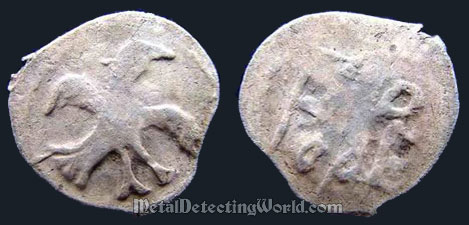
| < Prev. | ⇑ | Next > |

OBVERSE: Image of a bird with spread wings looking right.
REVERSE: the ornate legend engraved in old Cyrillic letters reads: "ГОСУДАРЬ" ("The Majesty").
Weight: 0.17 gram
Mint: Tver
According to scholars, the name of the coin's denomination, "Polushka", was first attested during the Coinless Period which lasted in Russia from the 12th through the early 14th century. During that period, silver coins began to disappear from circulation to be melted and cast into ingots called grivenkas, grivna-of-kunas and grivnas - an optimal medium for accumulation and storage of wealth as well as for large transactions in trade and commerce. When regular coinage became obsolete, it was replaced by monetary equivalents such as glass beads, slate spindles, seashells called cauri, "leather money" (small patches of leather marked with paint), and so-called "fur money".
The fur monetary units were actual pelts of bears, wolves, minks, foxes, beavers, sables and squirrels, and even their ears which were pierced with tiny silver earrings. Serving as a method of "payment in kind" in small transactions, these monetary units were used to describe the pelt's cut portions; hence their names: rezana, nogata, mordka, chetveretsa, belka and veksha (also called veveritsa).
The term "polushka" literally means "an ear's half". Because the name "polushka" represented the smallest fur monetary unit during the coinless period, the denomination of the smallest hammered Russian coin was given the same name when the minting of Russian coins resumed a century later. Sometimes the polushka coin was called "chetveretsa" meaning "one of four equal parts" and reflecting the Polushka's value that equalled to 1/4 of a Kopeck.
Number of pages:
Privacy Policy || Cookies Policy